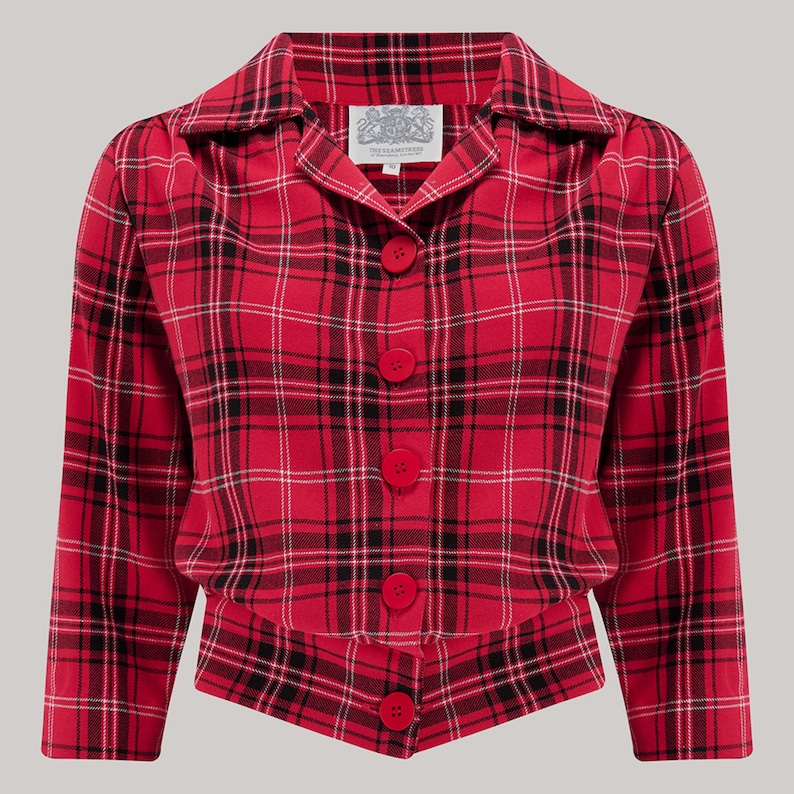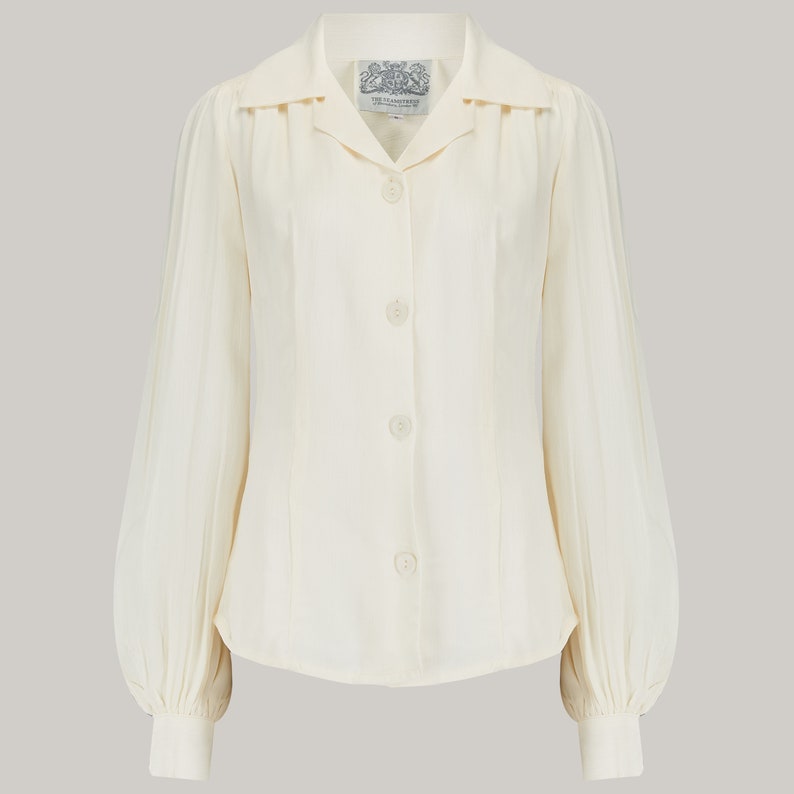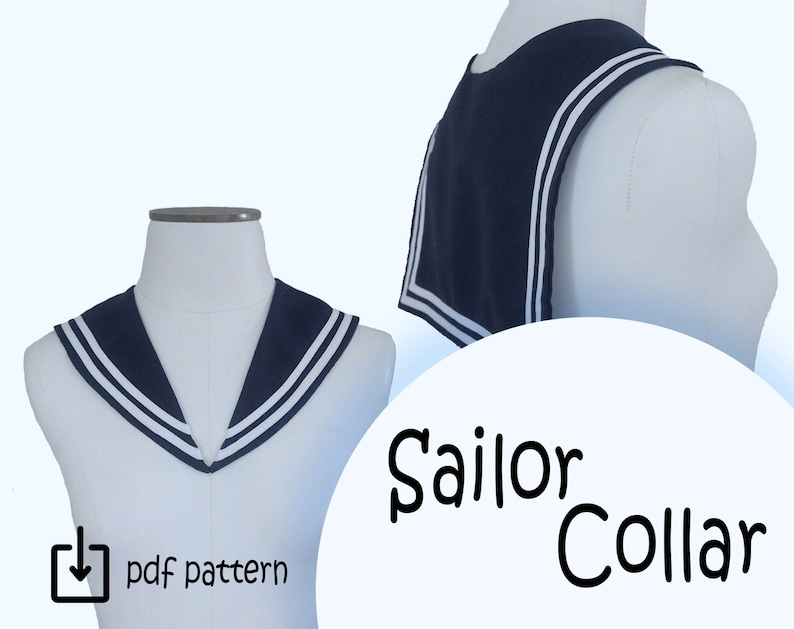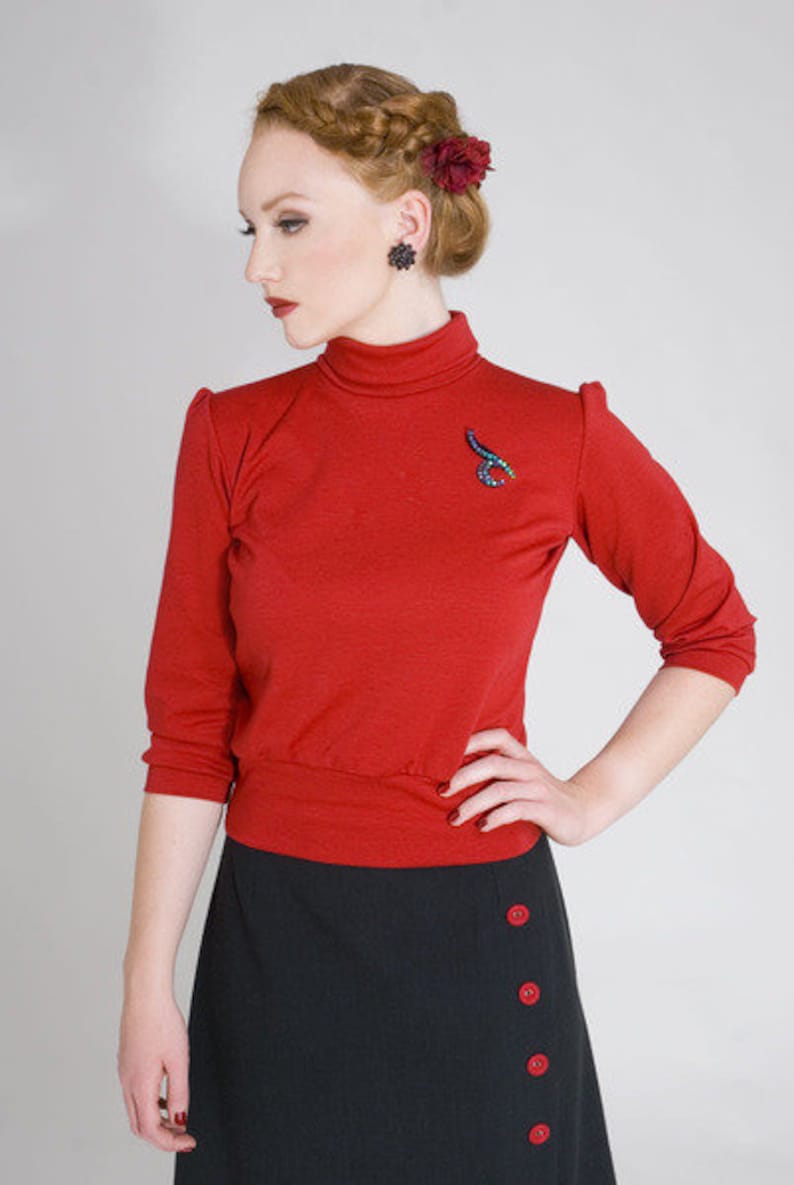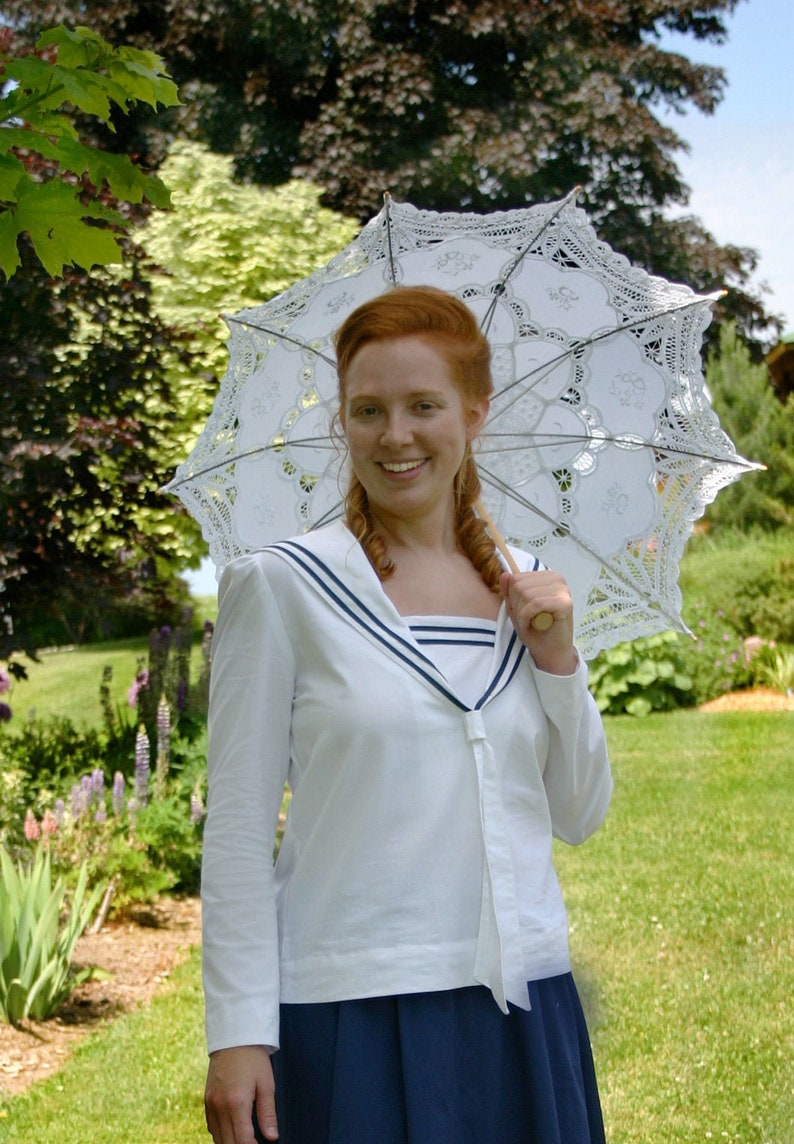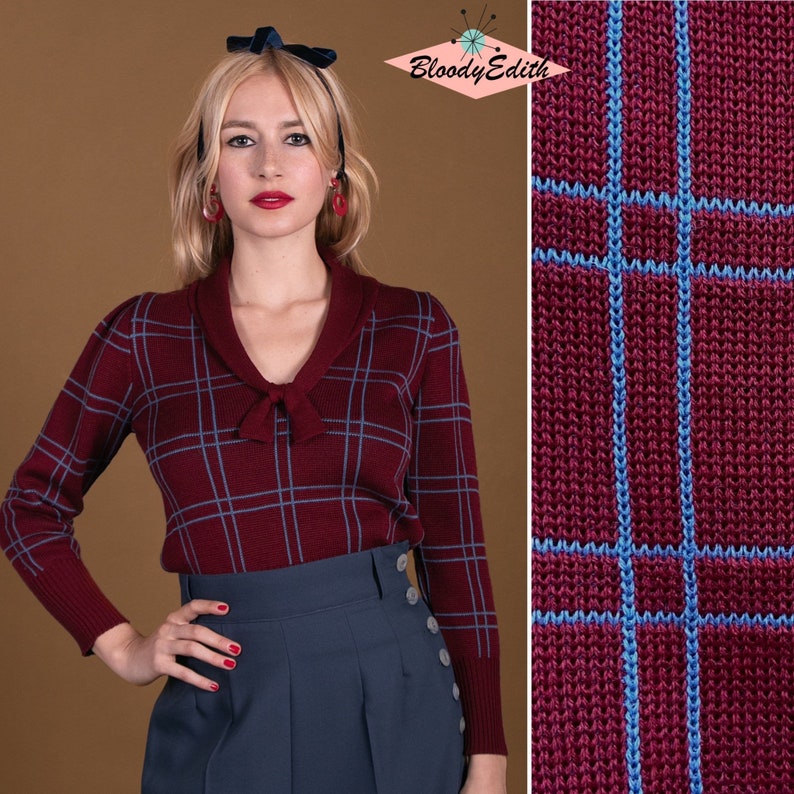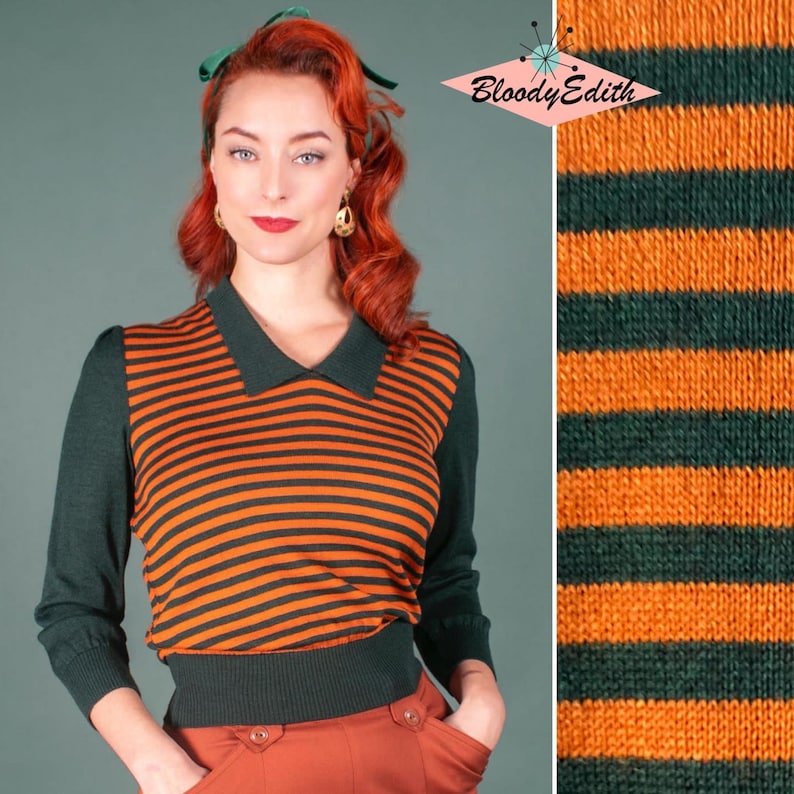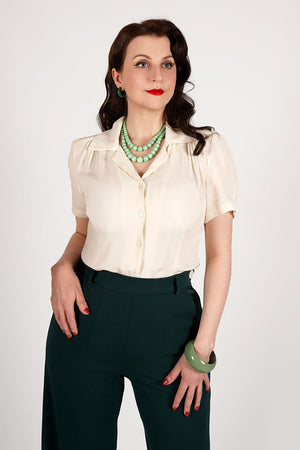
Blouse styles have not changed dramatically in the past few decades, but every era has a little something that makes its blouses different. 1940s blouses are easily identified from their tailored collars, button up fronts, and puff sleeves. Knitwear too followed many of the same style details as other 1940s tops and T- shirts.
In this article we will learned about common 1940s blouses styles, 1940s button down shirts, summer crop tops, casual 1940s T shirts and short sleeve knit tops. These pair well with 1940s wide leg pants, shorts and skirts.
Shop 1940s style blouses, tops, shirts and knitwear here.
1940s Blouse Styles
Blouses were always worn tucked into skirts or pants with a bit of blousing left out to keep them comfortable to move in. Inspired by the menswear fit, the 1940s blouse took on a different shape than the feminine 1930s which favored large bows, ruffles and flounces.
In the summer, short crop tops and knit t-shirts were the sporty and trendy tops to wear.

1942 long sleeve blouses
1940s Blouse Fashion History
WWII and the restrictions of L-85 made sure blouses, while pretty, were not too frilly or impractical to wear both on and off the job. Among other restrictions:
- There could only be one pocket.
- If tucks or pleats were used, a ruffle could not be, or vice versa.
- There could only be one ruffle per sleeve.
- There could only be two bows per shirt.
- Cuffs couldn’t be more than three inches wide.
These limits made early 1940s blouses simple and minimally decorated. The inspiration came from men’s dress shirts, which were tailored to a boxy or square body with equally angular point collars.
- 1941 button down pocket blouse
- 1941 stripe blouse
- 1941 polka dot short sleeve blouse
- 1941 banded bottom blouse
The one item that made them more feminine was the gathering on the top of the shoulder sleeves, which created a “puff” effect. This gave blouses a masculine broad shoulder with a softer ladylike touch.
Many blouses also came with shoulder pads to increase the width and square off the shoulder line. The sleeve puff was one element to decrease significantly in the 1950s, making it a fashion icon of the 1940s.
- 1943 leopard print bow blouse
- 1946 Silk Pintucks Blouse, collarless
After the war years when restrictions lifted, women’s fashion turned more delicate again with the addition of lace insets, ruffles, pintucks, tonal embroidery, string tie necks, shirring, pleats and gatherings. They looked more like Victorian era blouses than those of the prior few decades. The new, romantic look as termed the “Gibson Girl” style.
- 1944 Ruffle Trim Blouses
- 1948 ruffles, lace, pintucks, bows decorated blouses

1949 misses blouses
Blouses were made using pure silk or rayon crepe. Rayon satin could be used for a silkier look on budget, and cotton was used for casual and work wear. Wool jersey was a warm and comfortable alternative to summer weight fabrics.

1944 Jersey Knit Blouses
Blouses were fairly short, between 20 and 25 inches long. Sleeves were either long and full, coming to a tight wrist-cuff, or short-sleeved, hitting above the elbow. Sleeves were gathered at the shoulder and the cuff for long-sleeved versions creating a roomy tube of ample arm ease.

1943 Summer Blouses
Blouse colors were usually a plain white, cream, blue, yellow, red, or black. Later 40s colors included teal blue, pink, powder blue, and jade green.
Large plaids, checks, polka dots, and vertical stripes were also common. Blue and white or red and white stripes made women appear faithfully patriotic. Bold abstract patterns and colorblocks were seen in the later 1940s.
- 1942 Stripe Blouses
- 1947 Color Blouses
- 1947 Pattern and Color Solid Blouses
- 1947 Bold Print Blouses
Blouse collars came in the same styles as dress collars: pointed, like men’s dress shirt collars, or round Peter Pan collars of various sizes. Some had no collars, and instead were trimmed in a small ruffled edge. The bow tie neck blouses was seen throughout the 1940s, but was not as common as they had yet to be in the 1950s.
Many button up 40s blouses also had lapels leading up to the open collar while others buttoned all the way to a closed collar. Shirt buttons could either be covered to match the shirt material or were contrasting white.
- 1943 peter pan collar
- 1946 Silk Pintucks Blouse, collarless
- 1947 Bow Tie Neck Blouse
- 1948 Puritan Collar, Part of the Gibson Girl Look
Sleeveless Blouses
In summer, a short sleeve or sleeveless blouse (with large shoulder pads) was a welcome relief from the heat while remaining femininely forties. The same collars, ruffles, pintucks, and lace decorated these sleeveless blouses as they did long sleeved versions.
- 1947 Sleeveless Tops
- 1948 Sleeveless Blouses
1940s Shirts
The western trend had an effect on blouses as well as men’s workwear shirting. They took cotton gingham checks, plaid, windowpane or a solid color with a button down shirt front, classic point collar, and single chest pocket, and remade them in women’s sizes. Teenagers preferred to borrow Dad’s or Brother’s shirts, which were looser and longer.

1942 Ann Sheridan
Women wore these “sport shirts” with casual outfits and workwear, usually with slacks, overalls or jeans.
- 1943 Casual Man-Tailored Shirts
- 1946 Plaid Wool Shirts

1947 casual plaid shirt
Short sleeved 1940s shirts looked like a compromise between a blouse and men’s shirt. Fold out collars, button down front, single chest pocket, and elbow length sleeves with a faux cuff. White made them look blouse-y, while patterns gave them a workwear and casual vibe.
- 1949 White or Stripe Casual Blouse-Shirts
- 1949 Casual Cotton Summer Shirts

1946 stripe short sleeve shirt
1940s Crop Tops
What did teens, pinups, and young beach-loving women wear in the summer? 1940s Crop tops! The crop top or bolero top came down only to the lower rib cage, exposing about 3-4 inches of midriff! They were worn with pedal pushers, shorts, playsuits, and sometimes long pants.
Midriff tops, as they were usually called, looked like mini peasant tops, cap sleeve blouses, and button up cotton shirts. The styles were endless — as long as they showed off some skin!
- 1945 Tie Front Crop Tops
- 1947 Tie Front Crop Top with Ruffle Sleeves
- Mid 40s Crop Tops
- 1947 Crop Top with Button Details
1940s Peasant Blouses

1947 Peasant Blouses
One trend that surfaced in the ’40s was the peasant-style blouse, thanks to popular Latin Hollywood film star Carmen Miranda. It was made of white cotton and had short, puffed sleeves that gathered at the arm. It was also loose-fitting, with a scooped or square neckline, sometimes decorated with eyelet at the neckline and sleeves. Bits of ribbon were woven through the eyelets on these 1940s tops and tied in bows at the neck and on each sleeve.
The peasant blouse was worn with a gathered dirndl skirt / Alpine skirt made of colorful floral patterns or striped cotton, sitting at the waistline and flowing to a wide hem.
- Peasant Tops for Dirndl Skirts
- 1949 Embroidered Peasant Top
- 1948 ruffles sleeve peasant blouse (Esther Williams)
- 1947 Elizabeth Taylor’s peasant blouse
1940s Knit Tops and Knit Shirts
Nearly all blouses were made in a woven fabric. The exception was the short sleeve sweater knit top and T-shirt.
Knitted 1940s tops, which were called sweaters despite having short sleeves, came in pullover or button-down cardigan styles (called Midgies). They had puff sleeves, with high round necks and a slim fitting silhouette for most of the forties. They were designed to wear under suits or on their own over casual shorts, pants and skirts. The wide ribbed waistband hugged the upper hips and hourglass waist.
- 1940 Knit Short Sleeve Sweater Tops
- 1942 Puff Sleeve Pullover and Cardigan (Midgies)
- 1946 Knit Sweater Tops and Vest (Center)
- 1947 Simple Knit Sweater Tops
At the end of the decade, the sleeveless knit top took on a pullover vest appearance. It could be won over a long sleeve blouse or on their own in summer.

1949 Stripe Knit Sleeveless Tops and Vest
1940s T-Shirts
Sweater tops were usually a winter item but could carry over into spring, becoming the T-shirt. These light weight flat knit jersey shirts were taken from men’s undershirts and turned into sport shirts, called Tee shirts.
Women’s 1940s T-shirts could not be called the same thing as a men’s undershirts, so they were given the name polo shirt. That is still too confusing, because classic polo shirts had collar and a 1/4 button plaquette.
For the sake of clarity, I will call them T-shirts. Women’s 1940s T-shirts could be solid white but they were more often striped. Thin or wide stripes in blue, red, grey or black and white were the popular colors for summer casual outfits, paired with bottoms such as shorts and gym clothes.
- 1947 Red and White Striped T-Shirt
- 1944 Striped T Shirts
- 1948 Striped or White T-Shirts
- 1949 Striped Sport Shirts
Much like T-shirts today, it had a high ribbed crew neckline and short sleeves. The fit was slender and tapered at the waist, not tight or baggy. It could be worn tucked in to a waistband or out.
Similar modern shirts are called ringer tees when the color of the ribbed neck and band is different than the shirt body.
1940s Evening Blouses
Simple blouses and knits decorated with sequins, rhinestones, appliques and other cheap but sparkly materials found their way into the evenings. Learn more here.

1947 rhinestone trimmed sweater dress
Read More
- 1950s Women’s Tops and Blouse Styles
- 1930s Blouses and Top Styles
- Authentic 1940s Makeup Guide
- 1940s Sweater Styles, Knitwear History
Shop 1940s Style Blouses Today
I have a few vintage 1940s blouses that I love to wear when I feel like dressing 100% vintage. Otherwise, I like to wear vintage inspired or reproduction ’40s blouses and knit shirts on a day to day basis. Here are some good choices in the 1940s style.






































